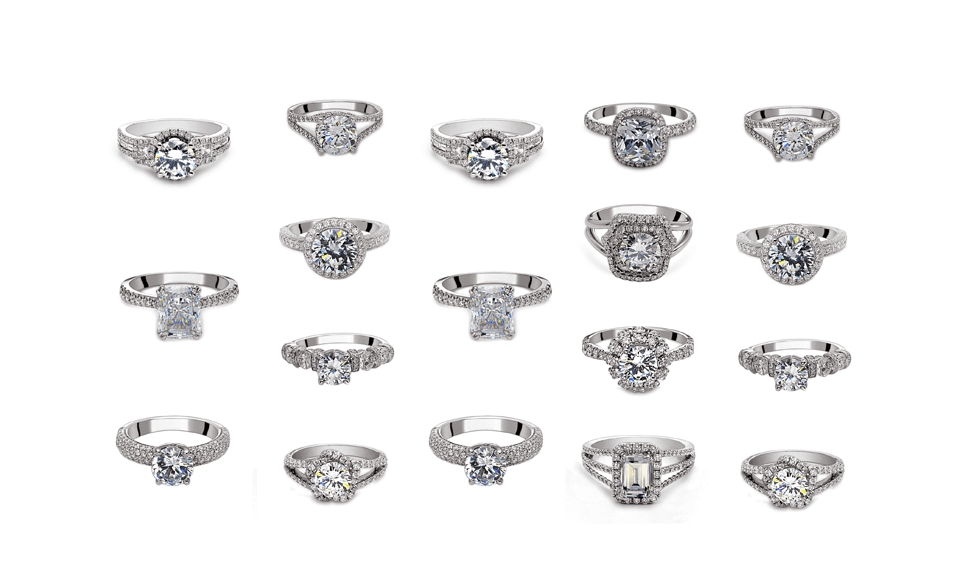Engagement rings are a gift that a partner gives to their prospective spouse which symbolises that the person wearing it is engaged to be married. In Western countries, these rings are generally worn by women and they will often feature diamonds or gemstones as a decorative feature.
Although Ancient Egyptians have previously been credited with having invented the engagement ring, the first throughly documented use of an engagement ring was by the Archduke Maximilian of Austria. Through an imperial court of Vienna in 1477, he gifted Mary of Burgundy a diamond ring to signify their engagement. His actions then influenced others with significant wealth and in higher social classes to give diamond rings to their prospective spouses.
Throughout 1714 to the 1950’s there have been seven different styles of engagement rings.
The first recorded style was Georgian, from the Georgian period, 1714 -1830. Jewellery from this period is rare and was handmade with 18K gold and silver. It was typical for Georgian rings to have many different shaped stones. This was because stones were not specifically cut to fit jewellery, instead jewellery was created to fit the stone. The reasoning for this was plainly because the cutting techniques we have available today were not achievable during the Georgian period due to the tools and processes they used.
The second period was the Victorian Era. This style lasted from 1835 – 1900 and was named after Queen Victoria. During the Victorian era, engagement rings often held birthstones instead of diamonds. This time period was also when the first recorded solitaire engagement rings were welcomed. When Queen Victoria passed away, after a 64 year reign, this marked the end of an era. Her son Edward ascended the throne which then ushered the next period, the Edwardian era.
The Edwardian era was when society was viewed to be at it’s height of sophistication and elegance. During this era, advances in the production and fabrication of metal allowed the use of platinum in jewellery. Throughout this time we began to see the development of light, feminine and airy styled jewellery. Diamonds were the most popular stones at this time but there was a rise in sapphires, aquamarines and green demantoid garnets. Another addition from this period was the use of milgraining which is a small border of platinum beads set around the edges of jewellery to assist in adding an elegant look. The Edwardian era ended brashly due to the beginning of World War I.
During 1895 – 1915, overlapping the Victorian and Edwardian era’s, the Art Nouveau period was a short but influential artistic revolt against the advances of technology. It was short lived but some of the most sought after jewellery in the world was produced from this time. It emphasised the importance of hand-craftsmanship, creativity and design. Moonstones, Opal and Agate were popular gemstones and diamonds were used sparingly to add artistic appeal. It was a highly artistic period which perfected the enameling of jewellery.
As World War I began, the Art Deco era also developed, 1915 – 1935. The main characteristic of jewellery from this period were the emphasis of bold, geometric designs. Lines were perfected as straight and linear and gemstones followed. Sapphires, rubies and emeralds were calibre cut and added colour to the diamond jewellery being produced. Platinum was still the preferred choice of metal but white gold grew in popularity as it was less costly.
During 1935 – 1950, the Retro period took over and it’s use of bright, polished gold and big bold dimensions gave it a turn in the spotlight. Common design elements were big bows and ribbons, animals and flowers. Society favoured bolder jewellery which was a characteristic of rings, earrings and bracelets being produced at this time.
From the 1950’s to now, we have been in the Modern era. With an abundance of gemstones, dramatic designs and once again, a focus on diamonds. Designs became more light and opposed to the bold products being produced in the Retro era. Platinum is still the metal of choice for many. Despite being the Modern era, it’s clear that aspects from past styles have maintained popularity through time.
Luckily, with the ability to design and create custom rings, perfection has been made possible.
Contact us at Polished Diamonds to begin the journey of creating your perfect ring.

